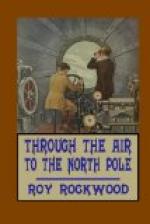Regular watches were established before the adventurers sought their bunks, and then, while the craft shot southward, quiet reigned aboard.
No further mishaps occurred. For some days the Monarch was kept on her course. Every hour it grew warmer until the fur garments were discarded, and at length the windows were opened and the fresh breezes blew inside the cabins. The temperate zone had been reached.
Over green meadows, woods, hills and valleys the airship flew; across wide bays, great rivers and large lakes. Now it was high in the air, above the clouds, and, again, close to the earth, as the captain directed.
At last, just at dusk one summer afternoon, a little less than a month from the time they had left, the inventor stopped the propeller.
“We are right above my old cabin,” he said. “Now we are going to land. This ends the voyage to the north pole, and we are back safe and sound.”
The ship settled down, about a hundred feet from the balloon shed, which remained the same as when the adventurers had left it. No one was in sight, and the travelers stepped out on the ground.
“If you will come inside I will pay you for your time, Andy,” said Mr. Henderson; “and you, too, Bill and Tom. You know I promised you good wages while you were with me, and I think you have earned the money.”
The hunter and the two helpers were liberally rewarded for the time they had spent. Bidding the professor good-bye, they went their several ways, to astonish their friends and acquaintances with their strange tales.
“As for you, boys,” went on Amos Henderson to Jack and Mark, “I will pay you, too, if you like, or you can continue with me, and perhaps some day we’ll make a trip to the South Pole—if not through the air, then under the sea, for I have in mind to build a submarine boat next. What do you say?”
“I’ll stay,” said Jack.
“So will I,” exclaimed Mark. “Hurrah for the South Pole!”
“Then come on in to supper,” cried the professor gaily, leading the way to his cabin.



